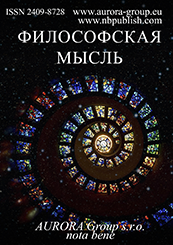Aesthetics
Reference:
Tiurina, S.N. (2025). Between image and depiction: The Second Commandment in the Context of Catacomb Painting. Philosophical Thought, 4, 1–25. https://doi.org/10.25136/2409-8728.2025.4.73641
Read the article
First Peer Review:
Second Peer Review:
Third Peer Review:
|
EDN: VLHHRS

|
Abstract:
Catacomb painting, formed in the context of the biblical prohibition on images (the Second Commandment), is a unique phenomenon of early Christian culture. The article analyzes methodological approaches to its study: iconographic analysis, concepts of identity, artistic style, dialogue and the role of the viewer. Special attention is paid to the juxtaposition of an "image" (a material object) and an "image" (a symbol indicating the transcendent), which reveals the apophatic principle of overcoming prohibition. The author criticizes the limitations of existing methods, offering an interdisciplinary analysis combining the context of the funeral space, rethinking ancient motifs and affective perception. Catacomb art is interpreted as an independent system, where prohibition is transformed into the aesthetics of absence, and symbols serve as tools for expressing the sacred. The study highlights the importance of combining art criticism, theological and philosophical approaches to study the visual language of catacomb painting in the context of religious and cultural features of Late Antiquity. The methodology combines iconographic analysis with concepts of identity, viewer, dialogue, style, and affect. Comparative and contextual approaches are used to evaluate methodologies and analyze the perception of the Second Commandment in early Christianity. Their ability to explain the uniqueness of catacomb painting beyond the limits of traditional art studies is evaluated. The relevance of the research is due to the increase in the number of works on catacomb art, including art criticism ("Catacomb" period in the art of early Christians" Kuznetsova-Bondarenko E.S., Tyulyukov D.I., 2020; "Funeral portrait in the art of early Christian catacombs" Obraztsova K., 2021) and cultural studies ("Evidence of painting Roman catacombs on the worldview of Christians of the pre-Constantine era" Chernova A.V., Sharkov I.G.; "Images of early Christian art in the context of the study of Christianity of the I–IV centuries" Lyakh E.E., 2017). However, there are no studies that systematize methodological approaches. The work fills this gap by offering a new perspective based on affective perception and the concept of the image as a means of spiritual communication. This approach allows us to take a fresh look at catacomb painting and the problem of overcoming the Second Commandment, going beyond the traditional art historical analysis.
Keywords:
Affective perception, Depiction, Image, Visual narrative, Philosophy of the image, Aniconism, Late Antiquity, Early Christian art, Second Commandment, Catacomb painting
 This work is licensed under a Creative Commons Attribution-NonCommercial 4.0 International License.
This work is licensed under a Creative Commons Attribution-NonCommercial 4.0 International License.
 Eng
Eng












 © 1998 – 2025 Nota Bene. Publishing Technologies. NB-Media Ltd.
© 1998 – 2025 Nota Bene. Publishing Technologies. NB-Media Ltd.




